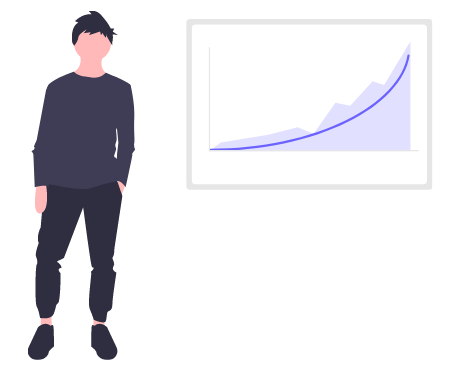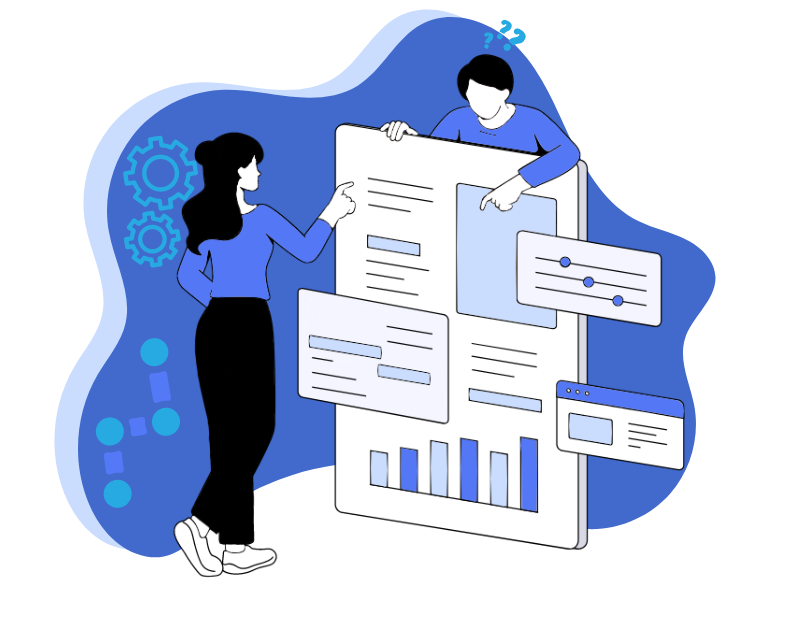A missed call is one that was not answered by an agent or an automated system and ended before a connection was established.
In this article, we will explore the reasons for missed calls and methods to calculate the percentage of calls that were not answered. We will also suggest ways to minimize the number of unanswered calls using Oki-Toki features.
How missed calls impact call center operations
Missed calls lead to several negative consequences that diminish the overall perception of a company by its clients. Key issues include:
- Deterioration of service quality: When customers can’t reach the call center, their loyalty to the service declines;
- Loss of sales and revenue: A missed call from a potential client represents a lost deal and increases the likelihood of them turning to a competitor, leading to a sales loss for the company;
- Increased agent workload: Calls can create a “snowball effect” as customers try to call again, increasing the overall load on the call center. This can lead to stress and fatigue among employees;
- Impact on reputation: Customers who do not receive a response may express their dissatisfaction by leaving negative comments on social networks or review platforms;
- Customer churn: A high number of unanswered calls may decrease the number of customers who feel the company is not interested in their inquiries.
Overall, unaddressed inquiries can seriously disrupt the performance indicators of a call center, worsen relationships with clients, reduce loyalty, and have a negative impact on financial metrics.
Why do we miss calls?
Every call missed by an agent is a loss for the call center. It is crucial to understand the reasons why customer inquiries go unanswered and to work on eliminating these issues.
Reasons for missed calls can vary:
- Peak load times: Holiday seasons and marketing promotions can lead to increased call volumes;
- Lack of lines: Insufficient lines provided by the service SIP provider to handle calls;
- Staff shortages: Not enough agents available on the line;
- Lack of discipline: Agents deliberately not taking incoming calls;
- Scheduling of agents: Improper allocation of staff across shifts without considering workload;
- Breaks in operations: Unmonitored departures from the workstation;
- Technical failures: Issues in software or telephony systems;
- Complicated IVR: Complex DTMF pathways and lengthy audio messages that fatigue customers;
- Long wait times in queue;
- Suboptimal call distribution among agents;
- Training during work hours: It’s important to maintain the necessary number of agents on the line when organizing training and seminars.
Oki-Toki features can address most of these issues, reducing the number of missed calls and improving service.
Abandoned call rate
To calculate the abandoned call rate, you can use the formula:

Alternatively, you can use:

Both formulas provide accurate results, with the choice depending on which data is easier to collect and process.
In Oki-Toki, you can obtain necessary data in several ways:
- Summary report: Provides an overview of call durations and waiting times, categorized by call type, users, queues, etc. This report helps assess agent performance, determine the number of missed incoming calls, and calculate the average call duration.

- Incoming call statistics: General metrics about call durations (DUR), average call duration (ACD), and the percentage of successful connections with agents (ASR), as well as the total number of incoming calls, categorized by telecommunications SIP providers.
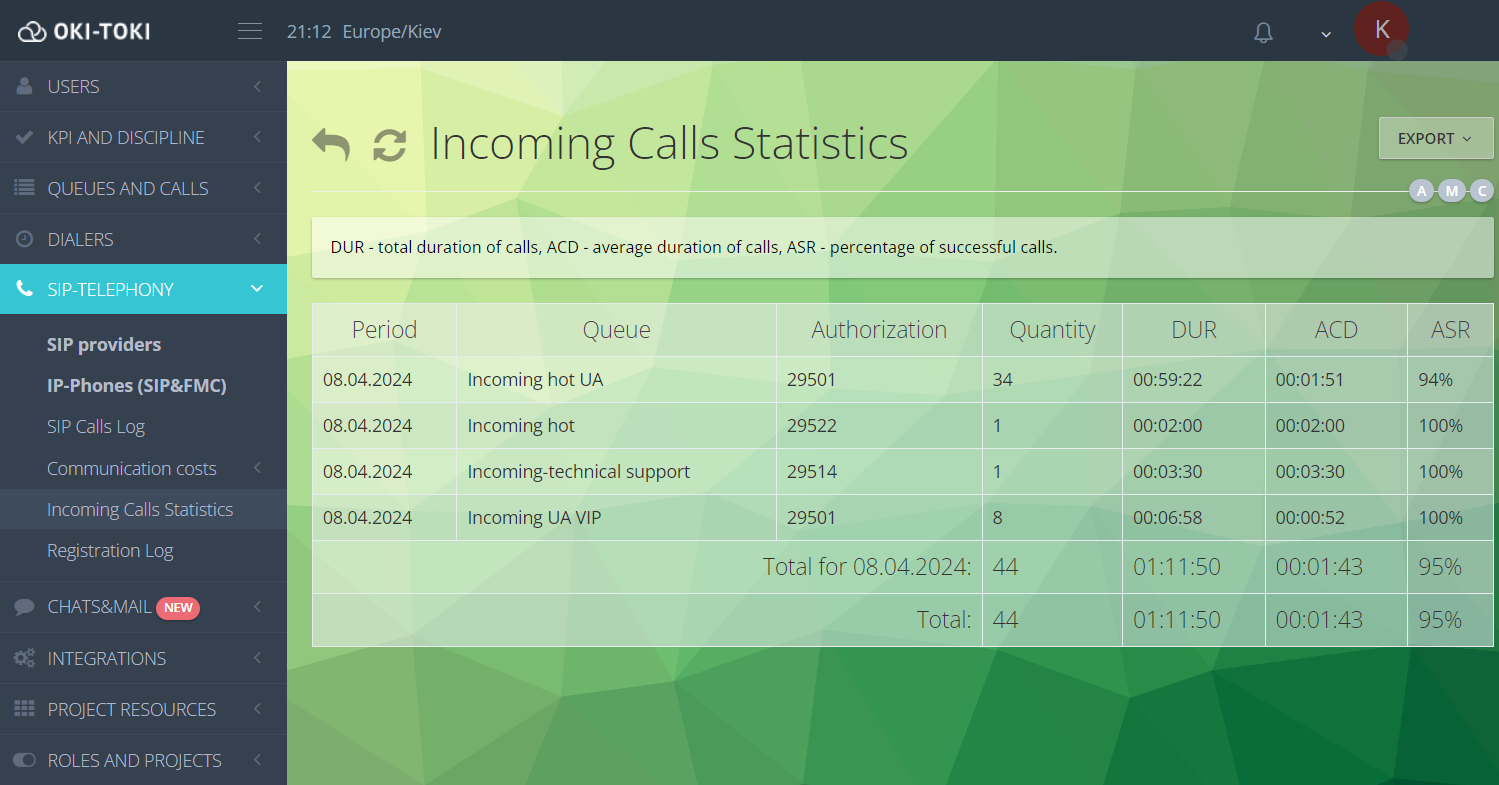
- Call tracking: Statistics of unique incoming numbers, waiting and talk times broken down by telecommunications SIP providers. For more detailed information about these reports, you can visit the blog.

- Report: To access information about incoming calls, select the “Calls” section and the “Incoming Details” part. The report generated will include data on the number of incoming, missed calls, and the periods with the highest call volumes.
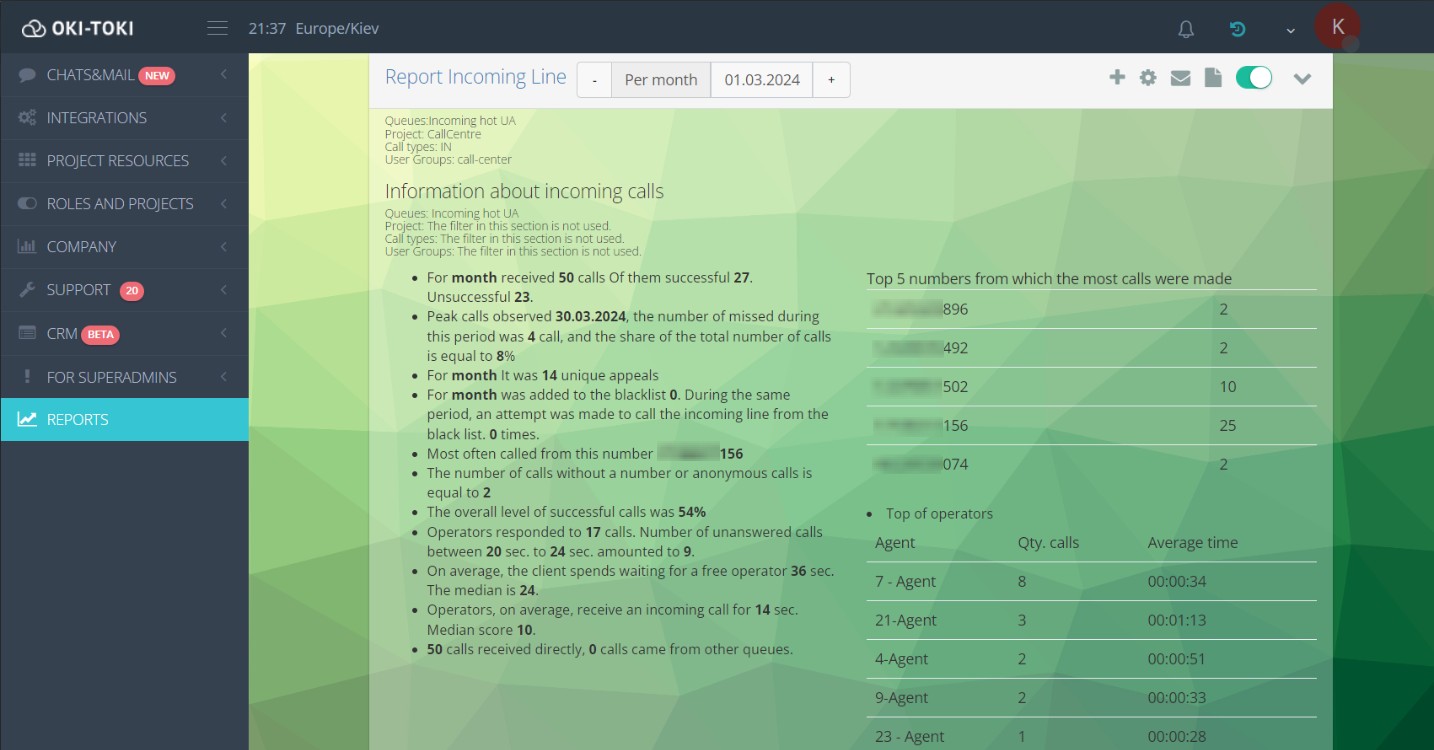
In Oki-Toki, you can monitor the abandonment rate, average waiting time for an agent’s response, and average queue duration (Average Speed to Answer) by selecting the “International Indicators” section in the Report.
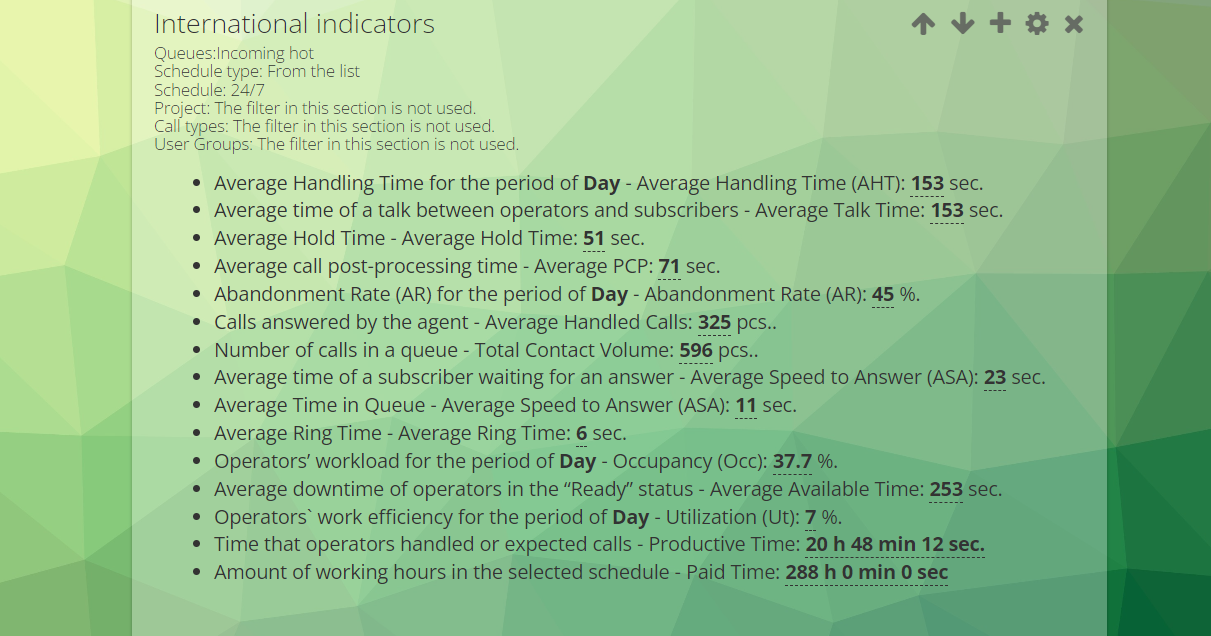
Using Reports, you can access crucial statistical information about the call center’s operation in a convenient format for any selected period. More details can be found in the blog article.
Acceptable abandonment rate
If the abandonment rate in a call center does not exceed 8%, this can be considered normal. However, it is important to remember that standard calculations might overlook some nuances that affect this rate:
- Misdialled Calls: A customer ends the call after realizing they have dialed the wrong number;
- Concurrent Queries: While waiting on the line, a customer also reaches out via chat. Once they receive a response there, they hang up the call;
- Repeated Calls: Tired of waiting, a customer hangs up and calls back shortly after;
- Connection Failures: Due to technical issues, the call may drop, prompting the customer to call again or seek another method of communication.
How to reduce missed calls?
For a call center, it’s critical to configure operations to minimize missed calls. Oki-Toki features help reduce the number of unanswered calls on the inbound line. Let’s discuss several useful functions for analyzing and minimizing the loss of customer contacts:
- Load analysis – Helps identify the busiest work hours and properly allocate agents. This will decrease the number of missed calls, as agents will find it easier to handle a larger volume of calls.
You can track agent activity in real time using the “Active Calls” widget in the Agent`s workplace and admin panel. It is useful for assessing agent performance online. If there are too many missed or waiting calls, you can add agents to handle calls directly during peak times.
- Number of communication lines – Having enough telephone lines helps reduce the number of missed calls by increasing the call center’s ability to handle more calls. This reduces the load on agents and speeds up the processing of calls, cutting down on customer wait times. In Oki-Toki, the number of available lines is unlimited, unlike with SIP provider conditions. Learn how telephony for call centers works on our blog.
- Number of agents – Having sufficient staff on the inbound line, especially during peak hours, significantly reduces the chance that a call will go unanswered. There are simple methods to calculate the necessary number of agents, as described in our articles.
- Intentional missed calls by agents – No company is immune from dishonest employees who might intentionally avoid answering client calls.
- Key performance indicators (KPI) – These help track an agent who has failed to respond to a call. Set the necessary standard in the KPI section. Dishonest agents can be detected through the KPI logs for further quality analysis of their work.
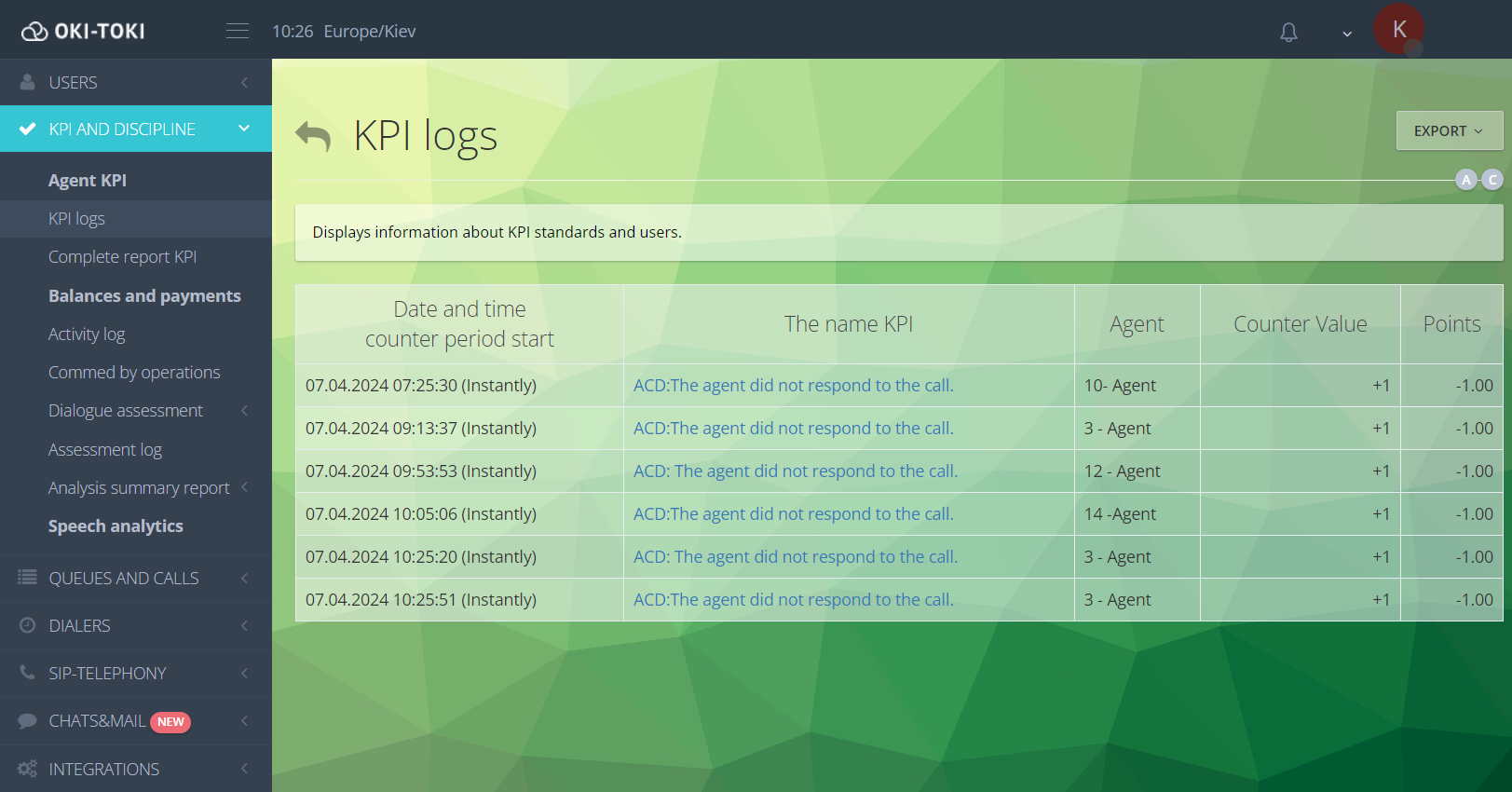
- Automatic call distribution – Allows for distributing calls among agents based on predefined rules and criteria.
In Oki-Toki, automatic call distribution can be implemented using priorities. Adjust the necessary level in the Queue settings. The higher the setting, the more calls are allocated to an agent. New agents may suit a low priority, while experienced employees can handle a high priority.

Setting a priority for the Queue itself allows searching for an available agent with varying intensity. Use the highest priority for busy queues. For queues where incoming calls are less frequent, you can lower the priority. This enables you to deploy agents where the workload is highest.
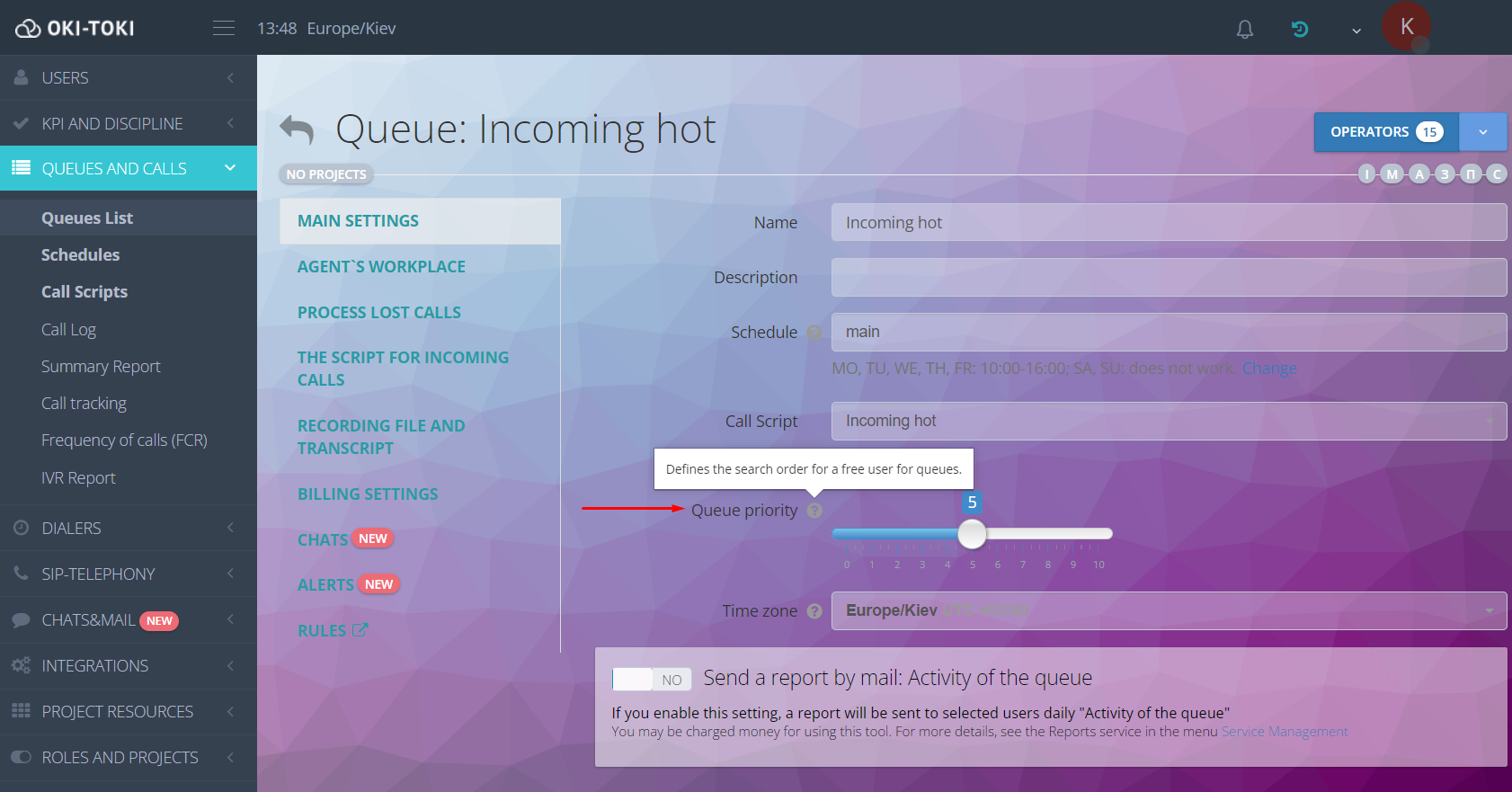
IVR (Interactive voice response) – Automates call distribution for interacting with customers via a voice menu, offering them to select the needed department or service without an agent’s involvement.
- Average speed of answer (ASA) – The typical waiting time on the line is about 30 seconds. If this time is exceeded, the likelihood increases that customers will hang up before an agent answers. You can adjust the necessary settings in Oki-Toki in two ways:
In the Call Script, adjusting the Queue block, specify the desired waiting period. Adjust this parameter based on the volume of calls and the average time agents spend talking. This setting will be applicable for all queues using the chosen script.
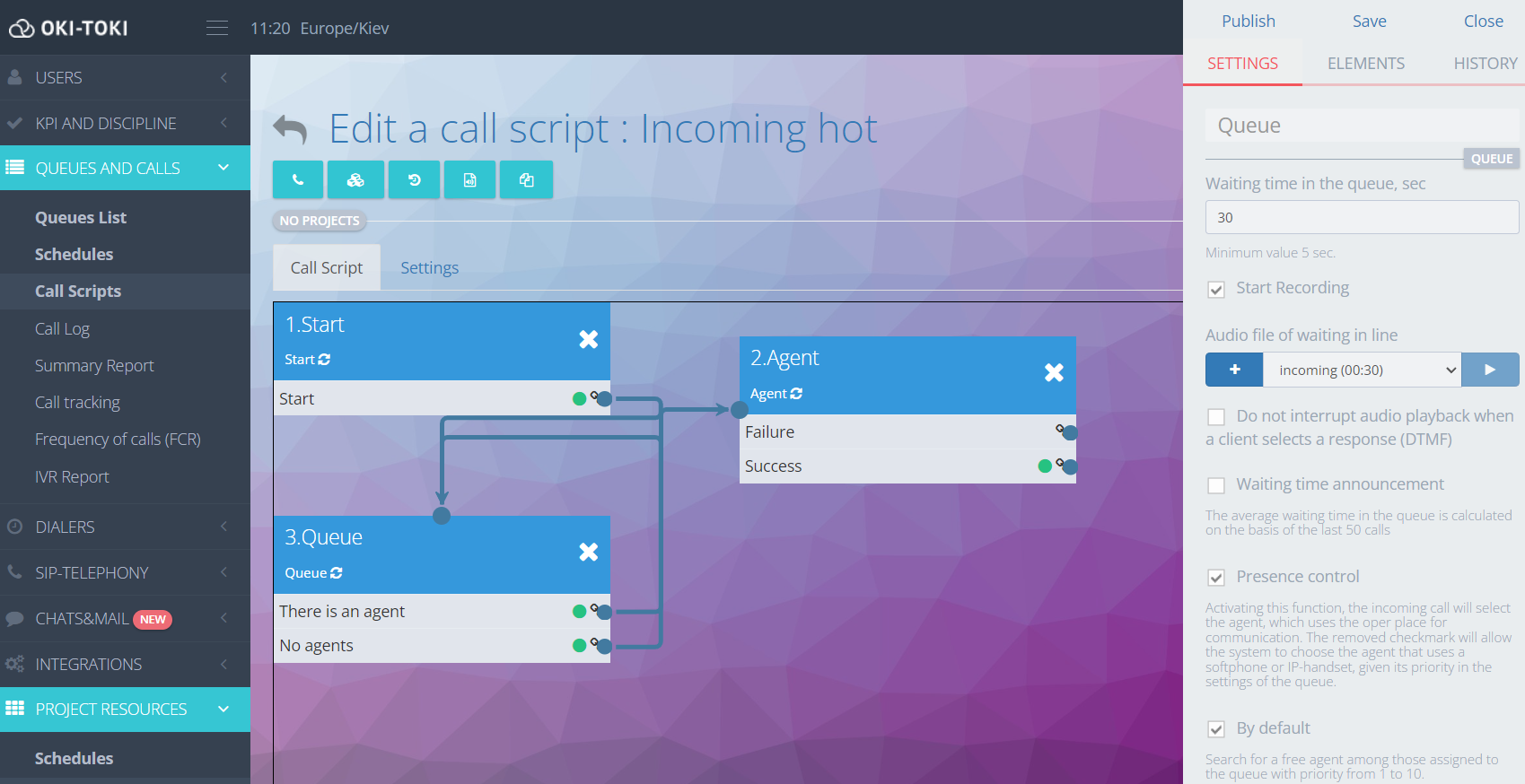
Similar settings can be made in the Queue section, “Call Script”.

- Agent scheduling – A well-organized work schedule increases the number of calls taken. When employees are efficiently distributed throughout the day, considering peak hours and customer needs, the call center can handle more inquiries without increasing stress for agents.
This is easy to set up: create an appropriate schedule and assign shifts for agents based on workload and peak call times.
- Breaks during work hours – During a work shift, agents may need to take breaks. This could be a lunch break, a work meeting, or a training session. If too few agents are left on the line, it could lead to missed calls.
In the Status section, set the number of agents who can simultaneously be in the “Away” status. You can adjust this for all agents or for each user group separately.
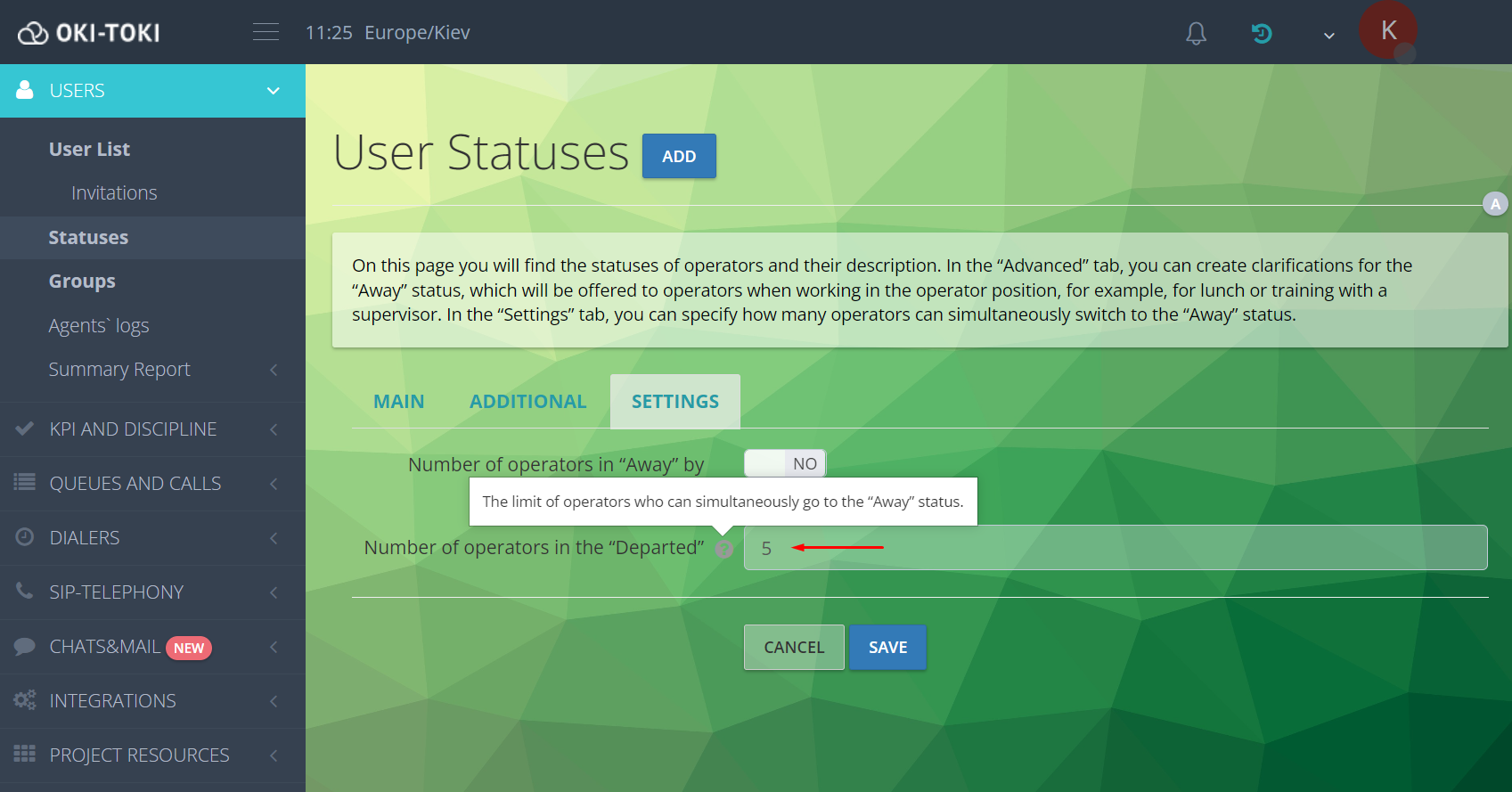
- In Oki-Toki, you can create additional statuses for agents who have left their workstations, such as “Away for Lunch”, “In Training”, etc. These will clarify the “Away” status.

- Agent groups – For distributing calls, agents can be grouped according to their skills or workload. Learn more about creating and managing user groups on the blog.
- Managing lost calls – If a customer doesn’t reach an agent, their number can be added to a callback dialer for a return call. Once an agent is available, they will automatically be reserved for that customer.
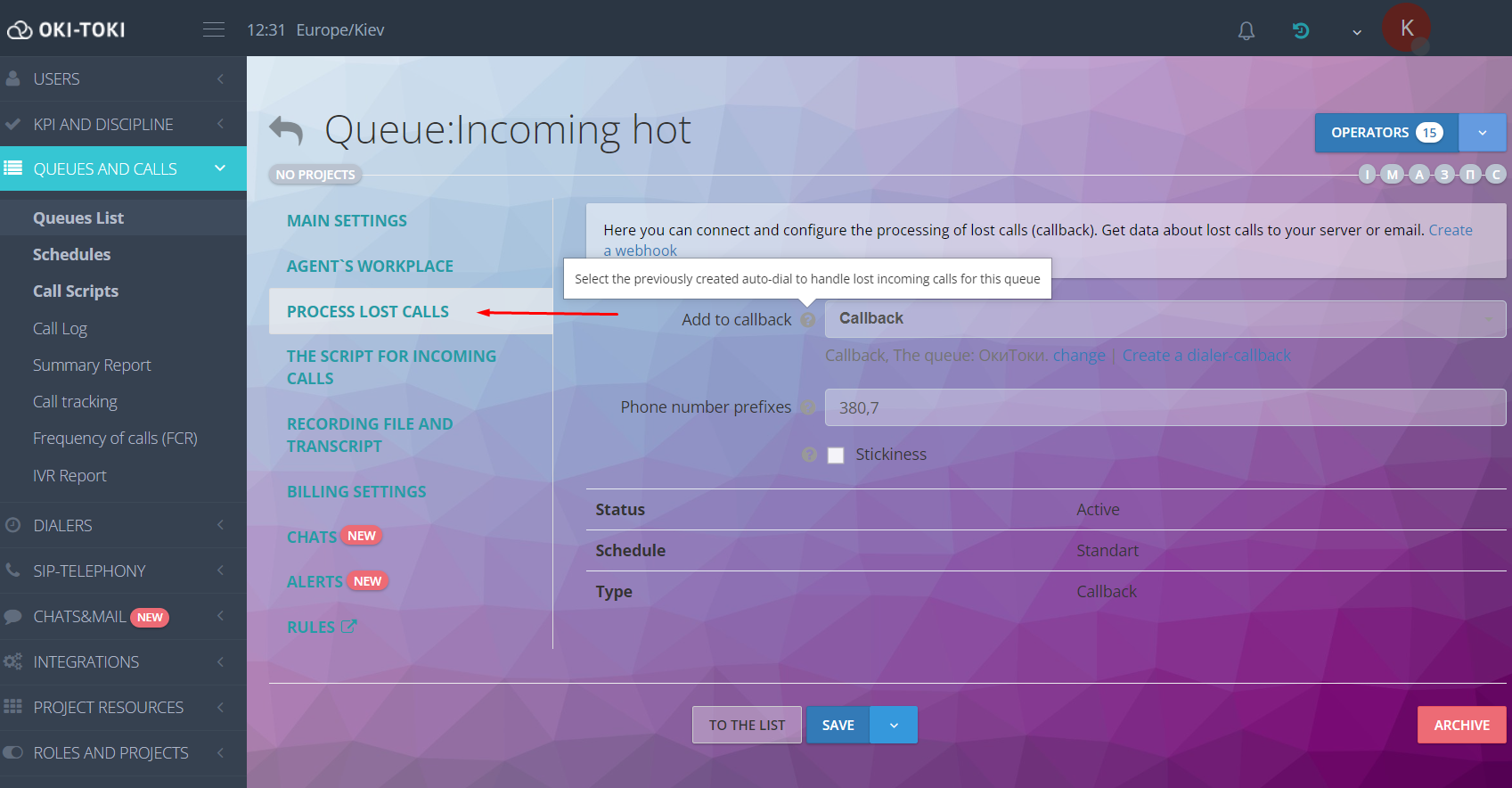
To use this feature, create a callback dialer in the Queue. The specifics of the callback operation ensure feedback with the client. More details about the settings can be found on the blog.
- Omnichannel Communication: Chat, Social Media, Email – Using various communication channels helps relieve the inbound line and ensures no clients are missed.
In Oki-Toki, all these communication methods are conveniently grouped in the Chats tool. In the Channels section, add the necessary channels, for example, E-mail, Viber, Telegram, Instagram, Facebook, and others. An agent can handle messages from different sources in one place.
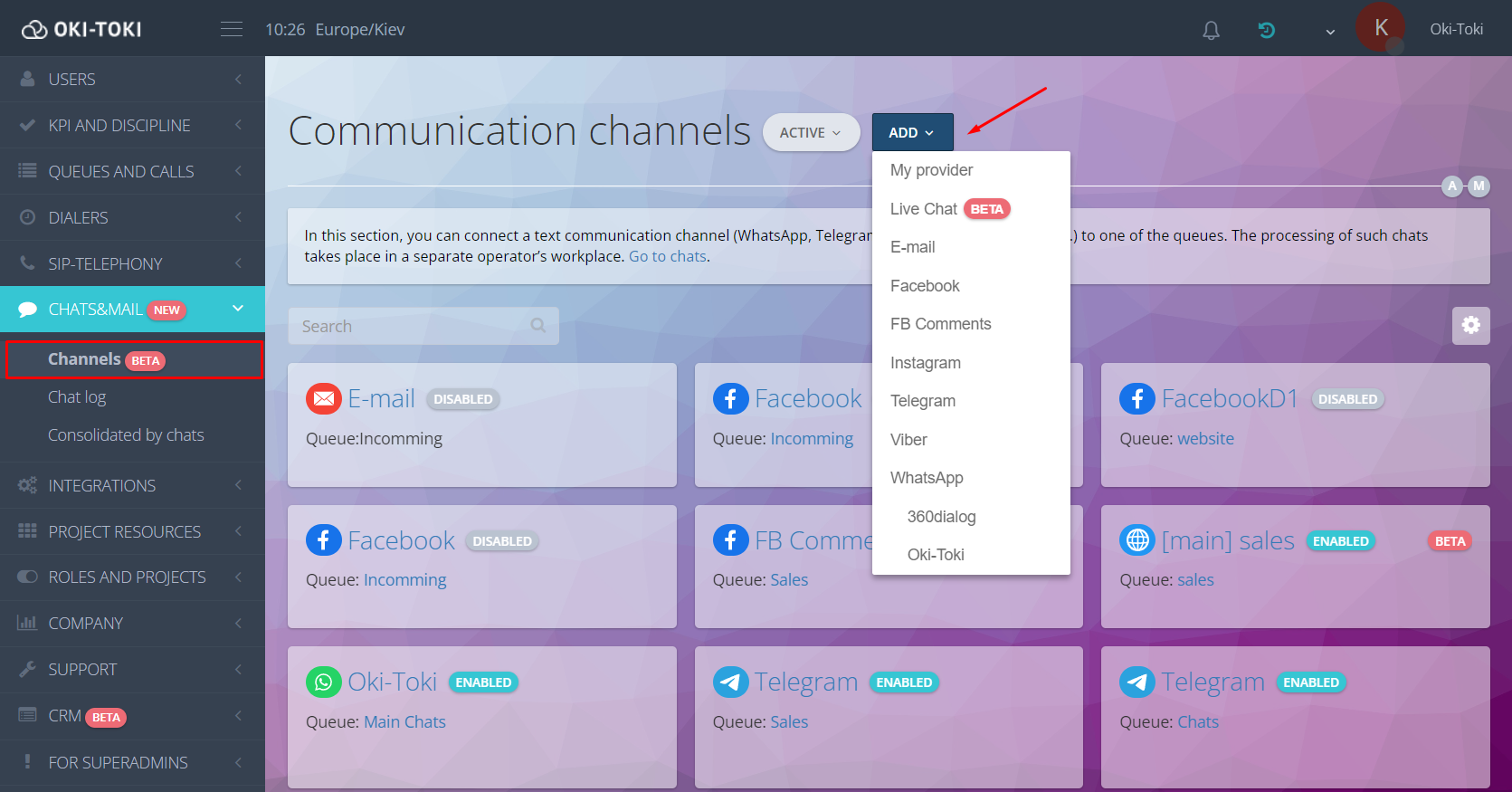
Learn more about integration capabilities, settings, and agent operations in chats on the blog.
Fully avoiding loss of incoming calls in a call center is a challenging task, with many factors influencing this process. With Oki-Toki tools, you can identify causes and adjust the inbound line to significantly reduce call losses. For a successful company, every call and every client is important, not only as an opportunity to increase revenue but also as a means to improve service, enhance, and strengthen loyalty to the brand.


